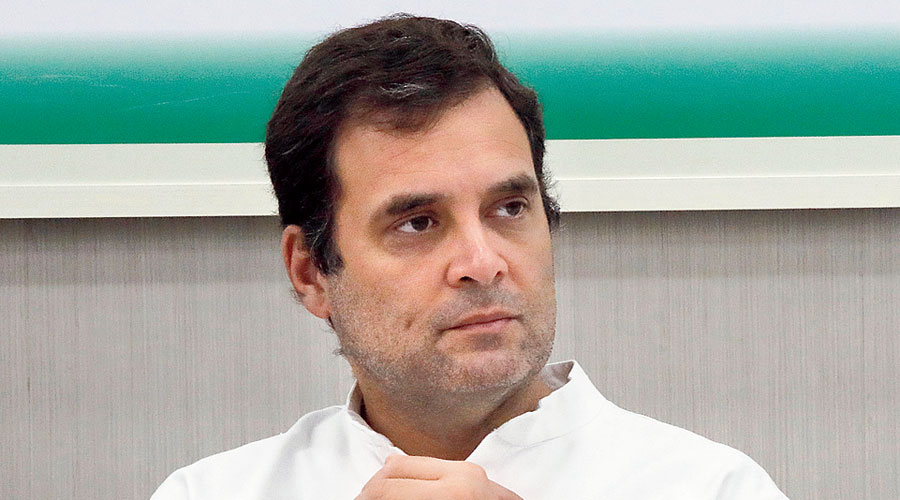The Congress Working Committee (CWC) is scheduled to meet on Monday morning amidst rising unease over the leadership question as Rahul Gandhi has so far not given any indication of his willingness to return as party president.
There is a distinct possibility that the process for the resolution of the lingering crisis will be set in motion at the CWC meeting. It is unlikely that Rahul’s return would be announced straightaway but the roadmap for the appointment of a new full-fledged president is expected to be laid out. This meeting may be more about addressing the sense of uncertainty in the party than to decide the leader.
But one section aligned with Rahul is working for his immediate return, fearing that conspiracies and factionalism would deepen if the uncertainty over leadership persists.
Asked if Rahul would return within months, in 2020 itself, an aide told The Telegraph: “Why months and weeks? Why not days? Why not on Monday when the CWC meets? Although he hasn’t revealed his mind as yet, we all want him to return on Monday itself. All he has to do is withdraw his resignation.”
This group of loyalists believes waiting for his return is the only option because they don’t want a cure that is worse than the disease.
They insist that Rahul had not abandoned the ship and had continued to lead despite relinquishing the top post. But that is what has created so much unease because most other leaders feel back-seat driving is harmful both for the party and Rahul’s own leadership.
These leaders, mostly seniors who have served the party for decades, are anguished by the stalemate, contending that the “drift” is weakening the political resistance to the Narendra Modi government.
Ironically, while nobody is opposed to Rahul’s leadership, there is turmoil linked to his tactics and approach. One leader said: “We are not discussing Rahul’s credentials as a leader; we all accepted him as president and never wanted him to resign. He has damaged his own leadership by exiting mid-way, when the need for guidance and motivation was more than ever before. We are saying ‘you come back, this vacuum is terrible’. Is that a wrong demand? Is that an issue to create such serious rifts in the party?”
Some younger leaders, however, have failed to read the nuanced positioning and presumed this group to be anti-Rahul. One leader said: “The party is not in turmoil; some leaders are in turmoil. These are the same people who enjoyed posts and political clout because of the blessings of the Nehru-Gandhi family. They are now restless because the new generation is trying to occupy their space. If they create nuisance at the CWC meeting, they will get a firm response. We won’t mind trouble-makers being expelled from the party.”
The widespread unease in the party over the leadership question has created a crisis of sorts and the majority of leaders disapprove of forcing Sonia Gandhi to run a “stop-gap” arrangement. This vacuum has reduced the goodwill Rahul enjoyed within the party and triggered avoidable fissures. A party that required restructuring and rejuvenation after successive debilitating electoral defeats to take on the formidable rival is stewing in its own juice.
Some seniors have proposed a collective leadership in case Rahul is still reluctant to return. That includes the formation of a top decision-making body called the Parliamentary Board and the appointment of zonal vice-presidents who can rev up the functioning of the organisation in the absence of an active president. Sources say that is not acceptable to Rahul, which is being seen as his refusal to accommodate some senior leaders in the system. This is another point of discord that has to be resolved.
It is in this tense atmosphere that an extended CWC meeting has been called. While the regular members of the CWC are mostly senior leaders, younger leaders enter in large numbers in the extended meeting as office-bearers in charge of states, special and permanent invitees and heads of frontal organisations. That will ensure an overwhelming presence of Rahul loyalists, making it difficult for the seniors who would like to underscore the gravity of the situation.
Another concern, though not very serious, is that the Election Commission of India may intervene to put the party in trouble over the leadership structure. Under the Representation of the People Act, every party has to submit to the commission the full list of its office-bearers and the details of internal elections. Although Rahul had been elected president till 2022, his resignation has created a situation that can enable the commission to step in.
The Congress had formally informed the commission on December 11, 2019, that Sonia had been appointed interim president because Rahul had refused to withdraw his resignation despite a unanimous request by all office-bearers for his continuance. Sonia’s term was extended till August 10 and hence the commission can seek an explanation now. Party leaders are, however, ready to contest that legally.











